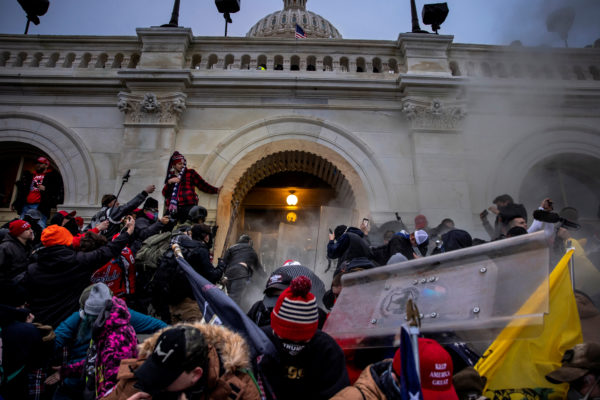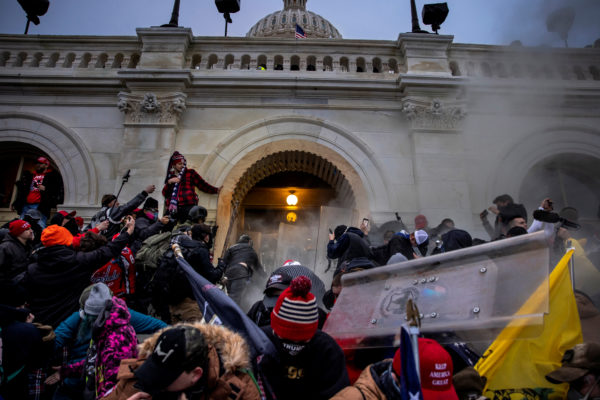‘It Was a Joke to Them Until We Got Inside’: New Details Emerge as Feds Confirm More Than 200 Alleged Capitol Rioters Arrested
The U.S. Department of Justice released court documents on Monday, Feb. 8, about dozens more insurrectionists suspected of storming the U.S. Capitol building in Washington on Jan. 6.
Federal authorities have identified and charged 211 alleged members of the deadly mob that breached the U.S. Capitol in an effort to stop Congress from certifying Electoral College votes installing Joe Biden as president, NBC News reports.
Five people, including Capitol Police Officer Brian Sicknick, died as a result of the melee.

Charging affidavits filed in federal court offer a deeper glimpse into the chaos that unfolded during the Jan. 6 coup attempt.
NPR examined the court documents. It’s no surprise that white men make up the predominant majority of defendants arrested so far — men outnumbered women by about 7 to 1. Many of them have ties to the military, law enforcement and militia groups.
But a former Latin Kings gang leader, a messianic rabbi, and two-time Olympian gold medalist swimmer Klete Keller are also among those who’ve been arrested by the feds.
Most of those arrested face disorderly conduct and unlawful entry charges that are tied to breaching the building. Twenty-five stand accused of committing acts of violence, and 15 are suspected of property damages such as breaking down doors or smashing windows to invade the building.
Twenty-two people face charges stemming from assaults on police officers. No charges have been filed in connection with the Sicknick’s death.
Only 11 of the defendants have been charged with the more serious crime of conspiracy.
Michael Sherwin, the acting U.S. attorney for the District of Columbia, told NBC that prosecutors are exploring seditious conspiracy charges for anyone identified as a leader of the riot. None of those charges had been filed by Monday.
The charging documents provide an overview of the insurrectionists and give insight into their motives for invading the Capitol.
One man told authorities he wanted to give his son a memorable experience, NBC reported.
“In many ways, Jan. 6 was a bug light. It brought extremists from all areas. And they all came with different skill sets,” Seamus Hughes, deputy director of the Program on Extremism at George Washington University, told NBC. “You have the militias on one side. On the other side, you have the merely curious, people wrapped up in the moment.”
According to NPR’s examination of the arrests, 31 are current and former military service members or law enforcement officers. Thirty-five of the arrested mob members had ties to extremist groups or fringe ideologies — 13 were supporters of the pro-Trump conspiracy theory movement QAnon.
Four have alleged ties to the militia group Oath Keepers, while 10 had apparent connections to Proud Boys. The FBI arrested Eduard Florea, a 40-year-old leader of the far-right gang, in his Queens, New York, home Jan. 12 for his alleged involvement in plotting a second Capitol siege.
The FBI has yet to identify who planted two pipe bombs near the Capitol the night before the attacks.
Among the five people left dead in the incident, Sicknick was struck in the head with a fire extinguisher. Roseanne Boyland, a Kennesaw, Georgia, woman, died from a medical emergency after she fell to the ground and was trampled during a clash between rioters and police.
Ashli Babbit, a 35-year-old Air Force vet, was shot in the neck by a Capitol Police officer as she tried to climb a makeshift blockade at a door to the Speaker’s Lobby near the House Chamber. The officer has not been identified, but police investigators have ruled that he should not face charges. The U.S. Attorney’s Office will make the final determination.
When Babbit was shot, she fell backward on Thomas Baranyi, a 29-year-old New Jersey man. Baranyi was a Peace Corps volunteer in Albania for two years. He enlisted in the U.S. Marines in July but failed to complete basic training, according to NPR.
Baranyi did an interview with a Washington, D.C., television station after Babbit was shot in the neck, and showed his bloody hands for the camera.
“It was a joke to them until we got inside and then all of a sudden, guns came out,” he said. “But I mean, we’re at a point now, it can’t be allowed to stand. We have to do something. People have to do something, because this could be you or your kids.”
Federal agents alluded to the TV interview in court documents, NPR reported. Baranyi described climbing scaffolding to breach the Capitol and running through flash bangs and tear gas.
“We blitzed our way in through all the chambers just trying to get into Congress or whoever we could get in to and tell them that we need some kind of investigation into this,” he said.
Several of the arrested rioters told investigators they got swept up in what they described as a historic moment and some expressed regrets for entering the Capitol building. Still, many of the defendants pledged their allegiances to then-President Donald Trump.
“I thought I was following my president,” one of the rioters said in court documents. Another was more forceful in their support for the former president, according to federal investigators.
“IF TRUMP TELLS US TO STORM THE F***IN CAPITAL IMA DO THAT THEN!”
Trump’s Senate impeachment trial for his role in fomenting the insurrection attempt began on Tuesday, Feb. 9.

